Wildland firefighter boots play a pivotal role in ensuring the safety and performance of wildland firefighters. In this comprehensive guide, we will explore the realm of these specialized boots, meticulously crafted to endure the harshest conditions and furnish firefighters with the essential protection and comfort required for peak job performance. Whether you are an experienced firefighter or simply curious about the gear they employ, continue reading to uncover all the vital information about wildland firefighter boots.
Table of Contents
ToggleWhat Are Wildland Firefighter Boots?
What are the Requirements for Wildland fire Boots?
NFPA 1977 Requirements:
- Minimum height of 8 inches from the bottom of the heel to the top of the boot.
- Minimum sole thickness of 1/4 inch at any point.
- A slip-resistant tread design that covers at least 75% of the sole surface.
- Flame-resistant upper material that does not melt, drip, or separate when exposed to fire.
- A flame-resistant sole material that does not ignite, melt, drip, or separate when exposed to fire.
- A closure system that does not include hooks, eyelets, or other metal parts that could conduct heat or snag on debris.
- Toe cap that protects from impact and compression.
- A heel counter that provides support and stability.
- Removable insole that provides cushioning and comfort.
- A shank that provides arch support and prevents punctures.
- A lining that provides insulation and moisture management.
- Finally, a label that indicates the manufacturer, model, size, width, and NFPA certification.
Other Standards and Certifications:
- UL Certified
- CAL FIRE Approved
- USDA Forest Service Specification 6170-4
Key Features to Look for in Wildland Firefighter Boots
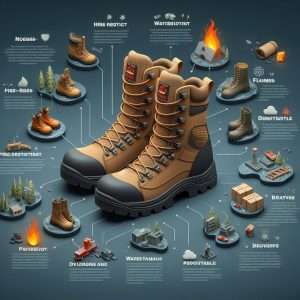

Fire-resistant materials:
Protective toe caps:
High shafts:
Slip-resistant soles:
Breathable and comfortable liners:
How to Find the Right Fit and Size for Your Wildland Fire Boots?
Measure your feet:
Check the size chart:
Try the boots on:
Check the fit and comfort:
What are the Best Wildland Firefighter Boots?
White’s Wildland Boots:
Haix Wildland Boots:


Scarpa Wildland Fire Boots:
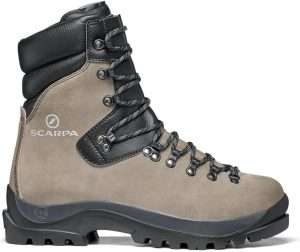

Nick’s Wildland Boots:


Danner Flashpoint II 10 Inch All Leather Work Boot:
 This is another esteemed brand of wildland fire boots that has been producing boots for the military and law enforcement since a certain year (which is missing in the text). This model has a Vibram Fire Logger sole, Nomex stitching, and fire-resistant leather. It is also NFPA certified and resoleable. These boots offer superior heat resistance, stability, and support, but they are also costly and stiff.
This is another esteemed brand of wildland fire boots that has been producing boots for the military and law enforcement since a certain year (which is missing in the text). This model has a Vibram Fire Logger sole, Nomex stitching, and fire-resistant leather. It is also NFPA certified and resoleable. These boots offer superior heat resistance, stability, and support, but they are also costly and stiff.
Chippewa 8” Steel Toe EH 27422 Boot:
 This is a more affordable and lightweight option for wildland fire boots. These boots are made of leather, Goodyear welt construction, and a Vibram Tacoma Logger sole. They are also NFPA certified and resoleable. While these boots offer good traction, flexibility, and comfort, they are less durable and protective than the other models.
This is a more affordable and lightweight option for wildland fire boots. These boots are made of leather, Goodyear welt construction, and a Vibram Tacoma Logger sole. They are also NFPA certified and resoleable. While these boots offer good traction, flexibility, and comfort, they are less durable and protective than the other models.
La Sportiva Glacier WLF Hiking Boot:
 La Sportiva Glacier WLF Hiking Boot is a unique and versatile option for wildland fire boots, as they are designed for both hiking and firefighting. These boots are made of leather, rubber rand, and a Vibram Ice-New sole. They are also NFPA certified and resoleable. These boots offer great breathability, cushioning, and grip, but they are less fire-resistant and supportive than the other models.
La Sportiva Glacier WLF Hiking Boot is a unique and versatile option for wildland fire boots, as they are designed for both hiking and firefighting. These boots are made of leather, rubber rand, and a Vibram Ice-New sole. They are also NFPA certified and resoleable. These boots offer great breathability, cushioning, and grip, but they are less fire-resistant and supportive than the other models.
What are the best fire boots for women?
When it comes to fire boots, women firefighters have distinct needs and preferences than men firefighters. Women’s feet are smaller, narrower, and more arched than men’s feet, so they require fire boots that are tailored to their anatomy and biomechanics. Women also have more sensitive skin and nails, necessitating the use of fire boots that are both comfortable and breathable.
Unfortunately, there aren’t many women’s fire boots available. Most fire boots are unisex, which means they are based on men’s sizes and forms and may not suit women well. However, there are some fire boots that are more suitable for women than others, based on their features and reviews. Some of the best fire boots for women are:
Danner Women’s Wildland Tactical Firefighter Boot
This wildland fire boot is designed for women who work in rough and difficult terrain. It boasts a tough leather and mesh upper for breathability and flexibility, as well as a Vibram sole for grip and stability. Also, it features a cushioned footbed and a molded polyurethane midsole for comfort and stability. It includes a lace-to-toe design for a customizable fit, as well as a lightweight and streamlined profile for increased mobility and agility.
Haix Women’s Airpower XR1 Dual-Certified Wildland, EMS, and Station Boot


Custom JK Boots Women’s Firefighter Boot
This is a custom-made fire boot that is designed for women who want a personalized and perfect fit. It has a premium leather upper that provides durability and flexibility, as well as a Vibram sole that provides traction and stability. Also, it has a removable orthotic insole and a leather-lined interior that provide comfort and support. It has a lace-to-toe design that allows for a customized fit, and a handcrafted and hand-stitched construction that ensures quality and longevity.
How to Find the Best Deals and Discounts on Wildland Fire Boots
- Compare prices online: Use websites like Amazon, eBay, Zappos, or Google Shopping to find the lowest prices and best deals.
- Look for clearance sales: Check online or local stores for clearance sales of old or discontinued models.
- Consider used or refurbished boots: Find these on platforms like eBay, Craigslist, or Facebook Marketplace, or ask around your fire crew or community. However, be cautious when buying used or refurbished boots, as they may have defects or damage.
How to Care for Your Wildland Firefighter Boots
Clean your boots regularly:
Dry your boots properly:
Condition your boots periodically:
Store your boots properly:
Ending Note
Frequently Asked Questions
1. Are all wildland firefighter boots waterproof?
Wildland firefighting boots are not completely waterproof. While some types are waterproof, others focus on breathability to keep feet cool. The decision is based on the firefighter’s individual demands and preferences.
2. What should I consider when choosing the right pair of wildland firefighter boots?
Boot material, sole type, heat resistance, ankle support, size, and waterproofing are all factors to consider. Also, ensure that they fulfill the safety criteria for wildland firefighting.
3. Are there any maintenance tips for the best wildland firefighter boots?
Yes, routine maintenance is essential. After each use, clean them, inspect them for wear and tear, and recondition the leather if necessary. Keep them dry and well-stored to extend their life.
4. Can I use wildland firefighter boots for other outdoor activities?
While these boots were built primarily for wildland firefighting, their robust build and longevity make them appropriate for other outdoor activities such as hiking and hunting.
5. How do I know if my wildland firefighter boots fit correctly?
Proper fit is essential for comfort and safety. Ensure there is enough room for your toes to move comfortably, but not so much that your feet slide. Also, check if they provide adequate ankle support.
6. What certifications should I look for in the best wildland firefighter boots?
Look for certifications like UL Certification, ASTM F2413, NFPA 1999, and NFPA 1977 when selecting the best wildland firefighting boots. These certificates guarantee that the boots fulfill industry safety requirements for protection in situations involving wildland firefighting. Check the product specifications or get in touch with the manufacturer to determine whether these certifications are present.
7. Do wildland firefighting boots come in different styles and colors?
A proper fit is critical for both comfort and safety. Allow enough space for your toes to wiggle easily, but not so much that your feet slide. Also, see whether they offer.
8. What boots do wildland firefighters wear?
Wildland firefighters frequently don protective boots that satisfy NFPA 1977 criteria. These boots offer flexibility and support, and they’re frequently constructed from strong leather and fire-resistant materials. Well-known companies with a strong reputation for dependability and attention to safety regulations are La Sportiva and Whites Boots. Given the demanding nature of the work, selecting the appropriate footwear is essential. You can help with the selection process by talking to seasoned coworkers or by adhering to departmental policies.
9. What boots does the forest service wear?
The Forest Service frequently wears boots made specifically for rough terrain. These boots provide essential protection since they adhere to industry requirements such as NFPA 1977. Common elements include fire-resistant materials and sturdy leather. Well-known brands with a safety record, like Whites Boots, are preferred. The Forest Service requires workers to wear appropriate footwear for the rigorous nature of their work. Following departmental policies or consulting with more seasoned coworkers might help determine the best boots to wear.
10. What is the NFPA standard for fire boots?
The NFPA standard specifically for wildland firefighting boots is NFPA 1977. This standard outlines criteria for the design and performance of boots, ensuring they meet safety requirements in challenging wildland environments. When looking for suitable footwear, it’s crucial to verify the “NFPA 1977” designation to ensure the boots comply with these essential safety standards.
11. Which are the best wildland firefighting boots women’s?
The La Sportiva Women’s Glacier WLF are a great option for women looking for the best wildland fire boots. These boots have an excellent reputation for being safe and long-lasting. For women fighting wildland fires, they are a dependable option since they combine protection and comfort. When choosing women’s wildland fire boots, give top priority to features like fire-resistant materials and conformity to NFPA standards for maximum safety and performance.
12. What boots do hot shots wear?
Hotshots often choose Haix wildland boots for their demanding work. These boots satisfy the strict requirements needed for combating fires and are well-known for their resilience and safety features. Hot shoots often choose Haix wilderness boots because they are dependable in difficult circumstances and offer protection and comfort.
13. How long are fire boots good for?
Fire boots have a limited lifespan and can deteriorate over time due to various factors, including natural wear and tear, extreme conditions, and usage. The National Fire Protection Association recommends replacing fire boots every five years, regardless of their condition. Signs that indicate that fire boots need to be replaced include worn-out soles, dented or exposed toes, torn or burned upper parts, broken fasteners, and improper fit. It’s important not to repair or modify fire boots as this can affect their safety and void their warranty and certification.
14. What do firefighter call their boots?
Depending on the region and culture, firefighters’ boots have varied names. Bunker boots, Fireman boots, and Logger boots are other common names.
15. Do firefighters have specific terminology for their boots?
Yes, firemen frequently use jargon to describe their boots. Understanding this jargon allows you to gain insight into the tight-knit culture of the firefighting community.
16. What makes Danner a reliable choice for fire boots?
Danner is known for its exceptional quality and durability. The brand consistently meets the rigorous demands of firefighting, making their boots a reliable choice for professionals.
17. How can I ensure the best fit when purchasing fire boots online?
Pay attention to sizing charts provided by manufacturers, read customer reviews for insights into sizing accuracy, and consider brands that offer return policies in case of sizing issues.
18. How do tread patterns contribute to the performance of fire boots?
Tread patterns are crucial for providing traction on various terrains. They enhance grip and stability, ensuring firefighters can navigate challenging environments with confidence.
19. Why is heel design an important factor in firefighting boots?
Heel design plays a pivotal role in stability and support during firefighting operations. A well-designed heel ensures balance and minimizes the risk of slips or falls in dynamic situations.
20. Can I customize my fire boots for a better fit?
Yes, customization is possible with brands like Custom JK Boots. Firefighters can tailor their boots for optimal comfort and performance, addressing individual preferences and specific needs.
21. What distinguishes wildland firefighting boots from structural firefighting boots?
Wildland firefighting boots are designed for outdoor environments and focus on heat resistance and comfort. Structural firefighting boots, on the other hand, meet specific standards for protection against heat, chemicals, and other hazards encountered in structural firefighting.
22. Are there specific firefighter boots designed for women?
Yes, many brands offer firefighter boots specifically designed for women. These boots prioritize a comfortable fit while maintaining the necessary safety features required for firefighting.
23. How do HAIX fire boots stand out in structural firefighting?
HAIX fire boots are renowned for setting the standard in structural firefighting. Their advanced features, including heat resistance and durability, make them a top choice among firefighters.
24. Where can I find real reviews and recommendations for the best firefighter boots?
Check online platforms like Reddit and Quora where the firefighting community shares experiences and reviews. These discussions offer valuable insights into the performance of different firefighter boots in real-world scenarios.
As an Amazon Associate and Adidas associate, I get money from qualifying purchases and may make money from links on this website.
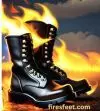

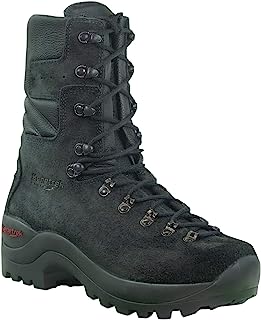

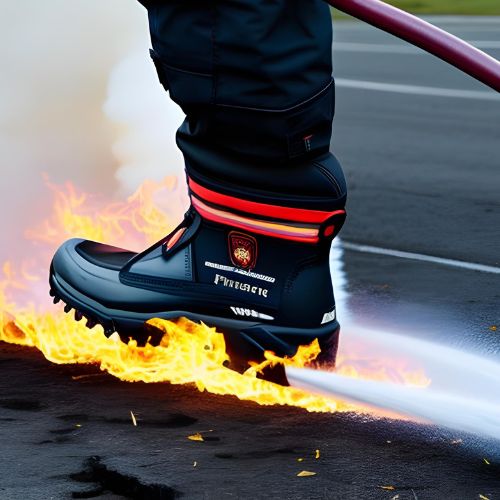



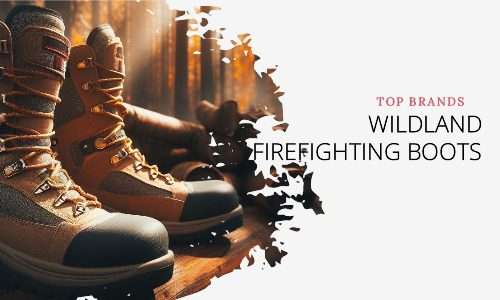

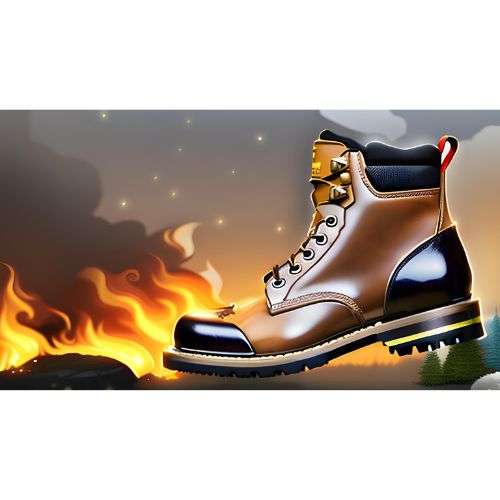
Pingback: Wildland Firefighting Boots Buying Guide: Key Features to Look For
Pingback: Where Are Brunt Work Boots Made?: Exploring the Origins
Pingback: Step into Safety: How to Choose the Best Snake Boots
Pingback: A Step-by-Step Guide: How to Enable Secure Boot for Valorant
Pingback: The Best (and Worst) Wildland Fire Boots Brands
Pingback: Top Brands for Wildland Firefighting Boots: A Detailed Review
Pingback: The Best Men's Work Boots: The Ultimate Guide
Pingback: How to Choose the Right Wildland Fire Boots for Your Needs
Pingback: Best Boots for Bunions: Finding Comfort and Style
Pingback: Best Lightweight Work Boots: Comfort, Safety, and Style
Pingback: How to Wear Ankle Boots with Jeans
Pingback: Best Tactical Boots: Your Ultimate Guide
Pingback: Ariat Firefighter Boots: The Ultimate Choice for Firefighters